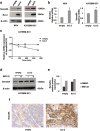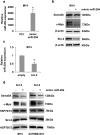Semaphorin 5A drives melanoma progression: role of Bcl-2, miR-204 and c-Myb
- PMID: 30454024
- PMCID: PMC6245779
- DOI: 10.1186/s13046-018-0933-x
Semaphorin 5A drives melanoma progression: role of Bcl-2, miR-204 and c-Myb
Abstract
Background: Melanoma, the most aggressive form of skin cancer, is characterized by high rates of metastasis, drug resistance and mortality. Here we investigated the role of Semaphorin 5A (Sema5A) on the properties associated with melanoma progression and the factors involved in Sema5A regulation.
Methods: Western blotting, qRT-PCR, Chromatin immunoprecipitation (ChIP) assay, immunohistochemistry of melanoma patient specimens and xenograft tissues, in vitro Transwell assay for cell migration and invasion evaluation, in vitro capillary-like structure formation analysis.
Results: A significant correlation of Sema5A mRNA expression and melanoma progression was observed by analyzing GEO profile dataset. Endogenous Sema5A protein was detected in 95% of human melanoma cell lines tested, in 70% of metastatic specimens from patients affected by melanoma, and 16% of in situ melanoma specimens showed a focal positivity. We demonstrated that Sema5A regulates in vitro cell migration and invasion and the formation of vasculogenic structures. We also found an increase of Sema5A at both mRNA and protein level after forced expression of Bcl-2. By use of transcriptional and proteasome inhibitors, we showed that Bcl-2 increases the stability of Sema5A mRNA and protein. Moreover, by ChIP we demonstrated that Sema5A expression is under the control of the transcription factor c-Myb and that c-Myb recruitment on Sema5A promoter is increased after Bcl-2 overexpression. Finally, a concomitant decrease in the expression of Sema5A, Bcl-2 and c-Myb proteins was observed in melanoma cells after miR-204 overexpression.
Conclusion: Overall our data provide evidences supporting the role of Sema5A in melanoma progression and the involvement of Bcl-2, miR-204 and c-Myb in regulating its expression.
Keywords: Bcl-2; Melanoma; Semaphorin 5A; c-Myb; miR-204.
Conflict of interest statement
Ethics approval and consent to participate
Experiments were approved by the Ethics Committee of IFO- IRCCS Regina Elena National Cancer Institute, Rome, Italy.
Consent for publication
All authors have read and approved the final manuscript and consent to publish.
Competing interests
The authors declare that they have no competing interests.
Publisher’s Note
Springer Nature remains neutral with regard to jurisdictional claims in published maps and institutional affiliations.
Figures






Similar articles
-
miR-211 and MITF modulation by Bcl-2 protein in melanoma cells.Mol Carcinog. 2016 Dec;55(12):2304-2312. doi: 10.1002/mc.22437. Epub 2015 Nov 24. Mol Carcinog. 2016. PMID: 26599548
-
miR-150 Suppresses Tumor Growth in Melanoma Through Downregulation of MYB.Oncol Res. 2019 Feb 21;27(3):317-323. doi: 10.3727/096504018X15228863026239. Epub 2018 Apr 24. Oncol Res. 2019. PMID: 29690954 Free PMC article.
-
MiR-140-3p is Involved in In-Stent Restenosis by Targeting C-Myb and BCL-2 in Peripheral Artery Disease.J Atheroscler Thromb. 2018 Nov 1;25(11):1168-1181. doi: 10.5551/jat.44024. Epub 2018 May 11. J Atheroscler Thromb. 2018. PMID: 29760303 Free PMC article.
-
New insights into the roles of antiapoptotic members of the Bcl-2 family in melanoma progression and therapy.Drug Discov Today. 2021 May;26(5):1126-1135. doi: 10.1016/j.drudis.2021.01.027. Epub 2021 Feb 2. Drug Discov Today. 2021. PMID: 33545382 Review.
-
Searching for the 'melano-miRs': miR-214 drives melanoma metastasis.EMBO J. 2011 May 18;30(10):1880-1. doi: 10.1038/emboj.2011.132. EMBO J. 2011. PMID: 21593728 Free PMC article. Review.
Cited by
-
Is miRNA Regulation the Key to Controlling Non-Melanoma Skin Cancer Evolution?Genes (Basel). 2021 Nov 29;12(12):1929. doi: 10.3390/genes12121929. Genes (Basel). 2021. PMID: 34946878 Free PMC article. Review.
-
Melanoma-specific bcl-2 promotes a protumoral M2-like phenotype by tumor-associated macrophages.J Immunother Cancer. 2020 Apr;8(1):e000489. doi: 10.1136/jitc-2019-000489. J Immunother Cancer. 2020. PMID: 32269145 Free PMC article.
-
Identification of Four Biomarkers of Human Skin Aging by Comprehensive Single Cell Transcriptome, Transcriptome, and Proteomics.Front Genet. 2022 Aug 23;13:881051. doi: 10.3389/fgene.2022.881051. eCollection 2022. Front Genet. 2022. PMID: 36081986 Free PMC article.
-
Similarities and Differences in the Protein Composition of Cutaneous Melanoma Cells and Their Exosomes Identified by Mass Spectrometry.Cancers (Basel). 2023 Feb 8;15(4):1097. doi: 10.3390/cancers15041097. Cancers (Basel). 2023. PMID: 36831440 Free PMC article.
-
RhoG-Binding Domain of Elmo1 Ameliorates Excessive Process Elongation Induced by Autism Spectrum Disorder-Associated Sema5A.Pathophysiology. 2023 Nov 27;30(4):548-566. doi: 10.3390/pathophysiology30040040. Pathophysiology. 2023. PMID: 38133141 Free PMC article.
References
MeSH terms
Substances
Grants and funding
LinkOut - more resources
Full Text Sources
Medical
Research Materials

